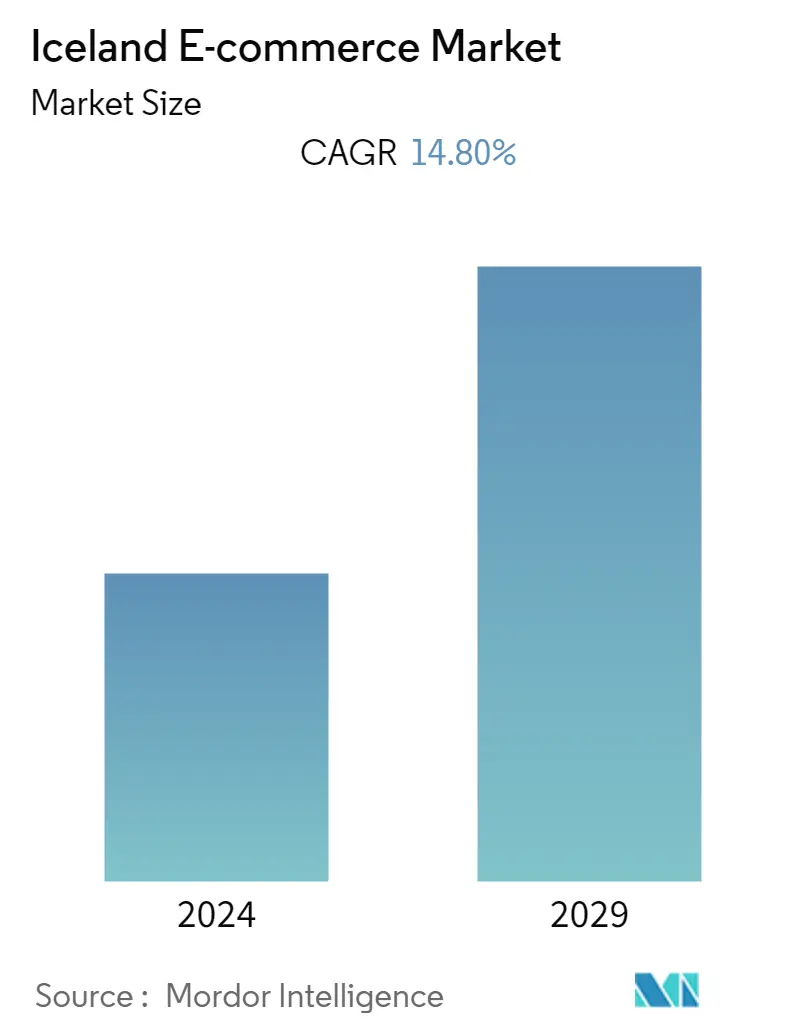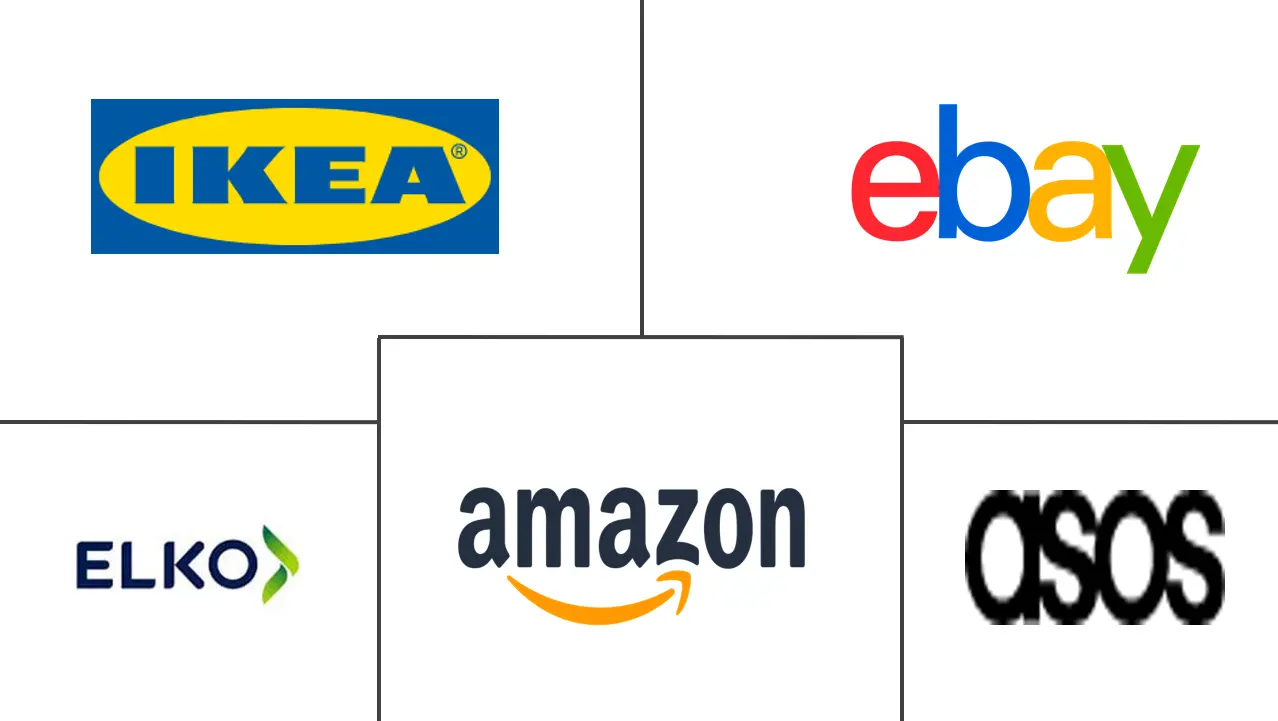Market Size of Iceland E-commerce Industry

| Study Period | 2019 - 2029 |
| Base Year For Estimation | 2023 |
| Forecast Data Period | 2024 - 2029 |
| Historical Data Period | 2019 - 2022 |
| CAGR | 14.80 % |
| Market Concentration | Low |
Major Players
*Disclaimer: Major Players sorted in no particular order |
Iceland E-commerce Market Analysis
The Iceland e-commerce market is expected to register a CAGR of 14.8% during the period 2022-2027. The primary factor driving the growth of the market in the region is the high rate of urbanization and intense Internet penetration, among others.
- Icelanders have very high internet usage, close to 99%, and in the past couple of years, online shopping has increased significantly, both from abroad and locally. Foreign e-commerce platforms are prevalent in Iceland, offering low-cost products across the region. The consumers in Iceland are also increasingly purchasing goods from American and European retailers, mainly fashion-related products, baby and beauty products, and electronic equipment.
- Furthermore, the high rate of urbanization, close to 94% (as reported by Hootsuite), is also paving the way for better infrastructure for the delivery of products by e-commerce companies in the region. With the high-tech and IT industries flourishing in Iceland, e-commerce is rapidly growing in Iceland as companies are increasingly offering their services online. This is further expected to boost the e-commerce market in the region.
- Digital marketing is widely used in Iceland. Many smaller e-commerce companies only advertise on social media, primarily Facebook, and many use social media influencers for marketing their products and services. Larger and more established e-commerce companies use digital marketing with a combination of conventional marketing.
- However, Iceland follows European e-commerce rules and regulations. A significant hindrance for online businesses in the region is high shipping costs, a high percentage of Value Added Tax (VAT), and handling fees charged by the local postal services, which can hamper the growth of the e-commerce market in the region.
- At the time of the COVID-19 pandemic, when most of the physical and brick-and-mortar stores were closed, the e-commerce market in the region grew owing to an increase in the strong demand for groceries, home furnishing, and pharmacy products. Many brick-and-mortar businesses introduced online channels for shopping in the region.
Iceland E-commerce Industry Segmentation
The Iceland e-commerce market is segmented by B2C e-commerce (beauty and personal care, consumer electronics, fashion and apparel, food and beverage, furniture and home), and B2B e-commerce.
| By B2C E-commerce | ||||||||
| Market Size (GMV) for the Period of 2017-2027 | ||||||||
|
| By B2B E-commerce | |
| Market Size for the Period of 2017-2027 |
Iceland E-commerce Market Size Summary
The Iceland e-commerce market is experiencing robust growth, driven by high urbanization and extensive internet penetration. With nearly all Icelanders using the internet, online shopping has surged, both from international and local platforms. The presence of foreign e-commerce sites offering competitive pricing has further fueled this trend, with consumers increasingly purchasing fashion, baby, beauty, and electronic products from American and European retailers. The flourishing high-tech and IT sectors in Iceland are contributing to the rapid expansion of e-commerce, as companies enhance their online service offerings. Digital marketing, particularly through social media, plays a significant role in promoting e-commerce, with both small and large companies leveraging these platforms to reach consumers. However, challenges such as high shipping costs, VAT, and postal handling fees pose obstacles to market growth.
The shift from offline to online shopping has been accelerated by the COVID-19 pandemic, which prompted many traditional retailers to establish online channels. The adoption of digital wallets is on the rise, facilitated by high mobile and internet penetration, making online payments more convenient for Icelandic consumers. Social media platforms, especially Facebook, are pivotal in driving e-commerce growth, with a significant portion of the population engaging in digital advertising. The fashion segment, particularly mobile commerce, is a key driver of e-commerce sales, with an increasing focus on enhancing mobile browsing and checkout experiences. The competitive landscape is fragmented, with major players like Amazon and eBay operating in the market. Recent developments, such as Iceland Foods extending its loyalty scheme to online shoppers and Rapyd's acquisition of Valitor, highlight ongoing efforts to enhance payment solutions and expand e-commerce capabilities in the region.
Iceland E-commerce Market Size - Table of Contents
-
1. MARKET INSIGHTS
-
1.1 Market Overview
-
1.2 Industry Attractiveness - Porter's Five Forces Analysis
-
1.2.1 Bargaining Power of Suppliers
-
1.2.2 Bargaining Power of Buyers/Consumers
-
1.2.3 Threat of New Entrants
-
1.2.4 Threat of Substitute Products
-
1.2.5 Intensity of Competitive Rivalry
-
-
1.3 Key Market Trends and Share of E-commerce of Total Retail Sector
-
1.4 Impact of COVID-19 on the E-commerce Sales
-
-
2. MARKET SEGMENTATION
-
2.1 By B2C E-commerce
-
2.1.1 Market Size (GMV) for the Period of 2017-2027
-
2.1.2 Market Segmentation - by Application
-
2.1.2.1 Beauty and Personal Care
-
2.1.2.2 Consumer Electronics
-
2.1.2.3 Fashion and Apparel
-
2.1.2.4 Food and Beverages
-
2.1.2.5 Furniture and Home
-
2.1.2.6 Others (Toys, DIY, Media, etc.)
-
-
-
2.2 By B2B E-commerce
-
2.2.1 Market Size for the Period of 2017-2027
-
-
Iceland E-commerce Market Size FAQs
What is the current Iceland E-commerce Market size?
The Iceland E-commerce Market is projected to register a CAGR of 14.80% during the forecast period (2024-2029)
Who are the key players in Iceland E-commerce Market?
Amazon.com, Inc., Inter IKEA Systems B.V, Elko ehf, eBay Inc. and ASOS.com, Ltd. are the major companies operating in the Iceland E-commerce Market.

